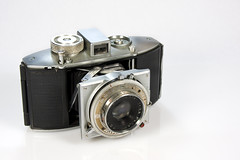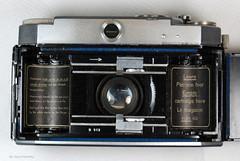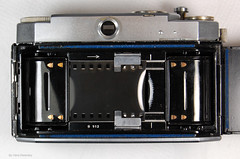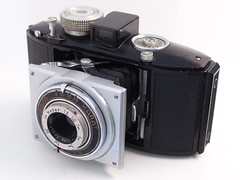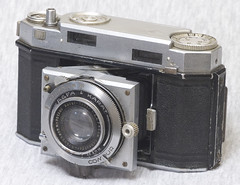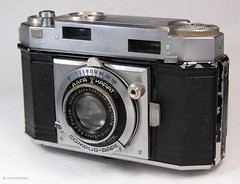Karat
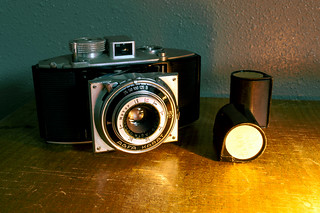
|
| the camera with empty film cartridges image by Mike Novak (Image rights) |
The Agfa Karats are a series of of strut-folding 35mm cameras made by Agfa. Two distinct series can be observed, first from the mid-1930s until the breakout of WWI and one from 1946 until the mid-1950s. These cameras use a proprietary film cartridge system, until 1948, when the Karat 36 began using the standard 35mm film cassette.
Contents
|
|
The Karat came with a new film cartridge developed from the Ansco Memo cassette of 1927 (Ansco and Agfa had merged in 1928). Compared to the Memo cassette, the Karat cassette was physically smaller, holding less film (12 full frames vs. 24), and had a modified shape[1]. The camera has to be loaded with a cartridge in which the film is provided and an empty cartridge of the same type. The film advance mechanism of the camera transfers the film step by step out of the one into the other cartridge. The piece of film lying inside the camera between the cartridges will always be fixed perfectly in the focal plane. The Karat cartridges are a light-tight version of a an older cartridge type of Agfa. 27 years later the Karat cartridges were revived as Agfa's Rapid film system.
|
| ||||
| Agfa Karat 12 showing the film transport system using the special Karat cartridges.
Images by Hans Kerensky (Image rights) | |||||
Karat 6.3 ArtDeco

|
| Agfa Karat 6.3 ArtDeco image by bratieres (Image rights) |
The first Karat has an unusual looking rounded cast aluminum body covered with a durable black synthetic material. The top cover is also rounded; both it and the flat bottom cover are painted black. The collapsible front plate, supported by four scissors struts, has an Art Deco style insert that has the shutter & f/stop settings. On the cast top cover is the shutter release and sliding time exposure lock, a Galilean tube viewfinder, a window for the internal frame counter, and the film advance knob, which interlocks with the Agfa self-cocking shutter for double exposure prevention. Also on the top cover are two strap lugs, and a release button to extend the lens standard, which locks in place. The lens standard release to allow the collapsing of the camera is on the left front of thew camera.
- Year of release: 1936
- Film Format: 35mm 12 exp in Rapid cassette
- Shutter: Agfa Automat B 25 50 100 (self cocking)
- Lens: Igestar 6.3/50 (three elements)
- Aperture: 6.3 to 22
- Viewfinder: optical direct vision viewfinder
- Flash: None
Karat 6.3
|
Similar to the Karat 6.3, the Karat has a larger viewfinder, an external frame counter on the top cover, and a simplified front plate. The lens settings are now on the lens bezel instead of the front plate, and the shutter time exposure lock is relocated to the front, between the top cover and the body. The camera now lacks strap lugs.
- Year of release: 1938
- Film Format: 35mm 12 exp in Rapid cassette
- Shutter: Agfa Automat B 25 50 100 (self cocking)
- Lens: Igestar 6.3/55 (three elements)
- Aperture: 6.3 to 22
- Viewfinder: optical direct vision viewfinder
- Flash: None
Karat 4.5
|
Similar to the Karat 6.3, the Karat 4.5's most noticeable difference is the use of brushed aluminum top and bottom covers. This model has an improved lens when compared to the two earlier models.
- Year of release: 1938
- Film Format: 35mm 12 exp in Rapid cassette
- Shutter: prontor B 25-125 (self cocking)
- Lens: Oppar 4.5/55 (four elements)
- Aperture: 4.5 to 32
- Viewfinder: optical direct vision viewfinder
- Flash: None
Karat 3.5
The last of the rounded body Karats. Similar to the Karat 4.5, the Karat 3.5's most significant difference is the use of Deckel's Compur and Gauthier's Prontor shutters. As these shutters are not self-cocking, a simple but ingenious method is used to remind the user to cock the shutter before shooting: when cocked, the shutter cocking lever is clearly visible in the viewfinder. The Karat 3.5 originally featured a 5cm f/3.5 Solinar lens; after the war, this was changed to the less expensive 55mm f/3.5 Apotar lens. Early Karat 3.5 models had a cast aluminum top cover with strap lugs and an aperture plate attached to the front lens standard. Later models had stamped covers and aperture scales on the lens bezel.

|
| late pre-war Agfa Karat 3.5 image by Jack Hufnagel (Image rights) |
- Year of release: 1938
- Film Format: 35mm 12 exp in Rapid cassette
- Shutter: Compur-Rapid B 1-500; Compur B 1-300; Prontor B 1-250; Prontor S 1-300
- Lens: Agfa Solinar 3.5/50 (pre-war, 4 elements) or Agfa Apotar 3.5/55 (post-war, 3 elements); both front cell focusing
- Aperture: 3.5 to 32
- Viewfinder: optical direct vision viewfinder
- Flash: Models with Prontor S
Karat 12 / Karat 2.8
| ||
|
The Karat 2.8 was the first of the second series of Agfa Karats. It was later called the Karat 12 to differentiate it from the newer Karat 36. The lens standard and bellows arrangement are basically identical to the Karat 3.5, while the body is entirely new. The Karat 12 has a combined viewfinder/rangefinder and a lever wind. The unusual split-image rangefinder, different from most, shifted the entire upper and lower halves of the viewfinder image when focusing and focus was achieved when the images coincided. This arrangement is very comfortable for use and allows focusing not only in the center.
The film advance lever, which now cocks the shutter, is also unusual in that it operates in the opposite direction (front to back), similar to the later Alpa reflexes. Another upgrade to the Rapid series is a depth-of-field dial located on the top cover where a rewind knob would be on a traditional 35mm camera, and a film reminder dial, located above the right viewfinder window. The film counter has been moved to the right side of the camera, and shutter time exposure lock and lens release button have been relocated as well to the front. Post-war models have a mushroom shaped shutter release, the top is removable to connect a cable release.
Sources vary as to the introduction of the Karat 12, most stating either 1941 or 1945. The example shown here has a pre-war Schneider Xenar lens dating from September of 1935, indicating that the Karat 12 was probably in production well before 1941. At any rate, due to the war, introducing a new consumer camera as late as 1941 seems unlikely.
Post-war Karats are equipped with Karat-Xenar Schneider lenses (5-element in 4 groups), that did not use the normal Schneider lens serial number sequence, using instead a low five digit number (14000-) as the factories were restarted. Post war Karats come in several versions, initially a similar version to the pre-war adapted to the existing materials called V1 and later V2 with the appearance of an accessory shoe in 1947. In these cameras the film winder acts as a double exposure prevention but doesn't cock the shutter, which is done with a lever like in most Compurs.[2] Some Compur-Rapid equipped cameras have a flash terminal in the front.
- Year of release: 1941? - Post war 1946
- Film Format: 35mm 12 exp in Karat/Rapid cassette
- Shutter: Compur B 1-300; Compur-Rapid B 1-500
- Lens: Schneider-Kreuznach Xenar 2.8/50 (five elements); unit focusing (32mm screw-on filters)
- Aperture: 2.8 to 16
- Viewfinder: Split image Rangefinder
- Flash: Some with Compur-Rapid
Karat 36

|
| early model Agfa Karat 36 (1949) image by Jack Hufnagel (Image rights) |
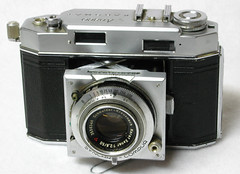
|
| 1951 Ansco (Agfa) Karomat 36 image by Mark O'Brien (Image rights) |
With the Karat 36, the series moved from the Rapid cassettes to the Kodak 35mm cartridge, though the Karat 12 remained in production for several more years. Outwardly nearly identical to the Karat 12, the most notable differences were: a film rewind knob replacing the depth-of-field dial (which now replaces the film reminder dial) on the top cover, a rewind button on the bottom cover, a folding articulated film advance lever, elimination of the lens release lever (the body mounted lens release lever now performs that function), an accessory shoe, and a shutter time exposure lock that rotates rather than slides.
Later models of the Karat 36 replaced the folding articulated advance lever extension with a non-folding lever with a larger cylindrical knob, eliminated the shutter time exposure lock, replaced the top depth-of-field dial with a more modern depth-of-field scale on the front lens standard, and have a shorter shutter release.
The Karat 36's top engravings varied significantly over the years.
The Ansco Karomat were re-badged versions of the Karat 36 cameras produced for the American Market. In 1953, it sold for $164US (over $1200 in 2007 US dollars - these were not cheap cameras!) At the same time, a comparable Contax IIA cost $440, and a comparable Leica IIIc cost $385.
- Year of release: 1948
- Film Format: 35mm
- Shutter: Compur-Rapid B 1-500; Synchro-Compur B 1-500
- Lens: Agfa Solinar 2.8/50 (four elements); Agfa Solagon 2.0/50; Rodenstock Heligon 2.0/50; Schneider Xenon 2.0/50 (all six elements)
- Aperture: 2.0 or 2.8 to 16
- Viewfinder: optical viewfinder with superimposed rangefinder
- Flash: X- , V- and M-synchronization
Karat IV

|
| Agfa Karat IV image by David Broglin (Image rights) |
The Karat IV upgrades the Karat 36 with a more conventional superimposed rangefinder and revised top cover.
- Year of release: 1954
- Film Format: 35mm
- Shutter: Prontor-SVS
- Lens: Agfa Solinar 2.8/50 (four elements); Agfa Solagon 2.0/50; Rodenstock Heligon 2.0/50; Schneider Xenon 2.0/50 (all six elements)
- Aperture: 2.8 to 16
- Viewfinder: optical viewfinder with superimposed rangefinder
- Flash: X- , V- and M-synchronization
Notes
- ↑ Agfa Memo
- ↑ Karat 12 versions at CJs Classic Cameras
Bibliography
Original documents
- W.D. Emanuel, Agfa Karat Guide, Focal Press, 1951 Available at Michael Butkus OrphanCamera site
Repair Notes
One of the most common faults on the Karat is that the focussing mechanism seizes. The grease used turns to glue. Forcing the focus lever spreads two legs that stabilize the lens and mechanism. On early Karats, the link to the rangefinder on one of these legs is screwed from underneath, making it necessary to partially remove the bellows, but on the 36, the screw is from the top making it easy to disconnect the rangefinder. It is then possible to undo the mechanism retaining ring inside the camera and drop the mechanism and lens out, leaving the bronze focussing mechanism exposed and possible to free up. One recently required heat from a hair drier to loosen the two pieces, but most just require oiling to free up, then cleaning, then re-greasing.
Laurie Pettitt. (Learning the hard way)
Links
- Karat-Kameras is a German website devoted to the Karat. [Click Skip Intro]
- Agfa Karat at Roland and Caroline's www.rolandandcaroline.co.uk
- Agfa Karat pages at CJ's Classic Camera Collection
- Pages at Sylvain Halgand's www.collection-appareils.fr (in French):
- Manual of the Karat IV at Michael Butkus Jr.'s www.OrphanCameras.com
- Agfa Karat 36 (standard 35mm film) at Michael Butkus Jr.'s www.OrphanCameras.com
- Agfa Karat 3,5 PDF manual, German at Michael Butkus Jr.'s www.OrphanCameras.com
- Manual of the Karat 2.8 / Karat 12 at CJ's Classic Camera Collection
- Manual of the Karat 36 at Pacific Rim Camera
